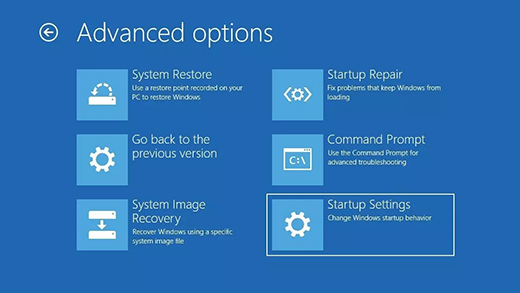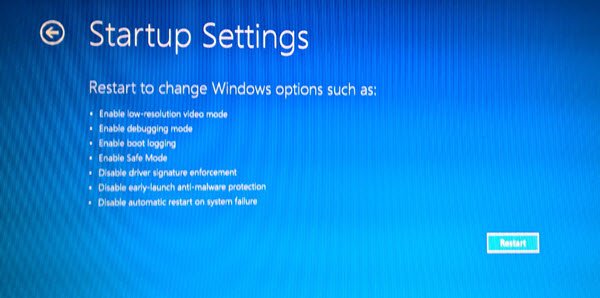
- #ADVANCED STARTUP OPTIONS WINDOWS 10 BOOT MENU INSTALL#
- #ADVANCED STARTUP OPTIONS WINDOWS 10 BOOT MENU DRIVERS#
- #ADVANCED STARTUP OPTIONS WINDOWS 10 BOOT MENU UPDATE#
- #ADVANCED STARTUP OPTIONS WINDOWS 10 BOOT MENU DRIVER#
This option is unnecessary unless you’re having a problem with the Windows graphical interface. The third Safe Mode option, Safe Mode With Command Prompt, loads the same stripped-down set of services as Safe Mode, but it uses the Windows command interpreter (Cmd.exe) as a shell instead of the graphical Windows Explorer (Explorer.exe, which also serves as the host for File Explorer).
#ADVANCED STARTUP OPTIONS WINDOWS 10 BOOT MENU DRIVERS#
If you need access to network connections, choose the Safe Mode With Networking option, which loads the base set of Safe Mode files and adds drivers and services required to start Windows networking.

To restore a system image backup, for example, you need to use the Windows Recovery Environment, not Safe Mode.

One important troubleshooting tool that is not available in Safe Mode is Backup And Restore. Then try restarting the system normally to see whether your changes have resolved the problem.
#ADVANCED STARTUP OPTIONS WINDOWS 10 BOOT MENU DRIVER#
Use Device Manager to uninstall or roll back a hardware driver use Control Panel to remove a desktop program or utility. If you suspect that a newly installed device or program is the cause of the problem, you can remove the offending software while you’re running in Safe Mode. Use Device Manager, Driver Verifier Manager, and Event Viewer to try to figure out where the trouble lies. If Windows appears to work properly in Safe Mode, you can safely assume that there’s no problem with the basic services. In Safe Mode, you can access certain essential configuration tools, including Device Manager, System Restore, and Registry Editor. All programs that normally run when you sign in (programs in your Startup folder, for example) are bypassed.

USB flash drives, hard disks, keyboard, and mouse are supported.
#ADVANCED STARTUP OPTIONS WINDOWS 10 BOOT MENU INSTALL#
In Safe Mode, Windows does not install support for audio devices and nonessential peripherals. The operating system runs with a generic video driver, with support for keyboard, mouse, monitor, local storage, and default system services. The three choices in the middle enable Safe Mode, which starts Windows using a built-in administrator account, using only services and drivers that are absolutely required to start your system. The nine choices shown there (one additional option is on the next screen) allow you to start Windows in modes that make some forms of troubleshooting easier.įigure 17-12 The Startup Settings menu lets you boot into Safe Mode to remove a troublesome program or driver that is preventing you from signing in normally. After restarting, you can tap Troubleshoot, Advanced Options, and finally Startup Settings to reach the blue, full-screen menu shown in Figure 17-12.
#ADVANCED STARTUP OPTIONS WINDOWS 10 BOOT MENU UPDATE#
To get to the Startup Settings menu, open Settings, Update & Security, Recovery, and then click Restart Now under Advanced Startup. Clicking Restart while holding down Shift makes an alternative boot menu available, with some interesting troubleshooting options.

If you can start Windows and get to the sign-in screen, you can then hold down Shift and click the Power button in the lower right corner of that screen. On modern hardware, with UEFI firmware and solid state drives, it’s literally impossible to interrupt the boot process to switch into Safe Mode. Booting into Safe Mode, for example, used to be a mandatory step for recovering from problems. The recovery and reset options in Windows 10 make some traditional troubleshooting techniques less important than they used to be. Troubleshooting with alternative boot optionsīefore there was Reset, there was Safe Mode.


 0 kommentar(er)
0 kommentar(er)
